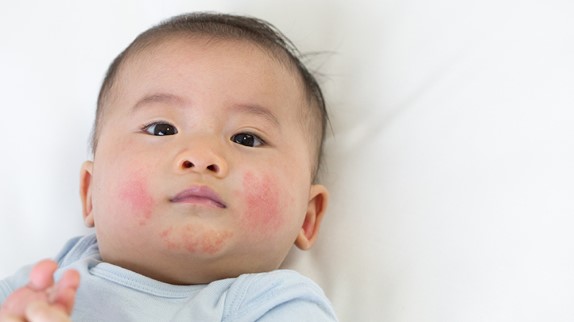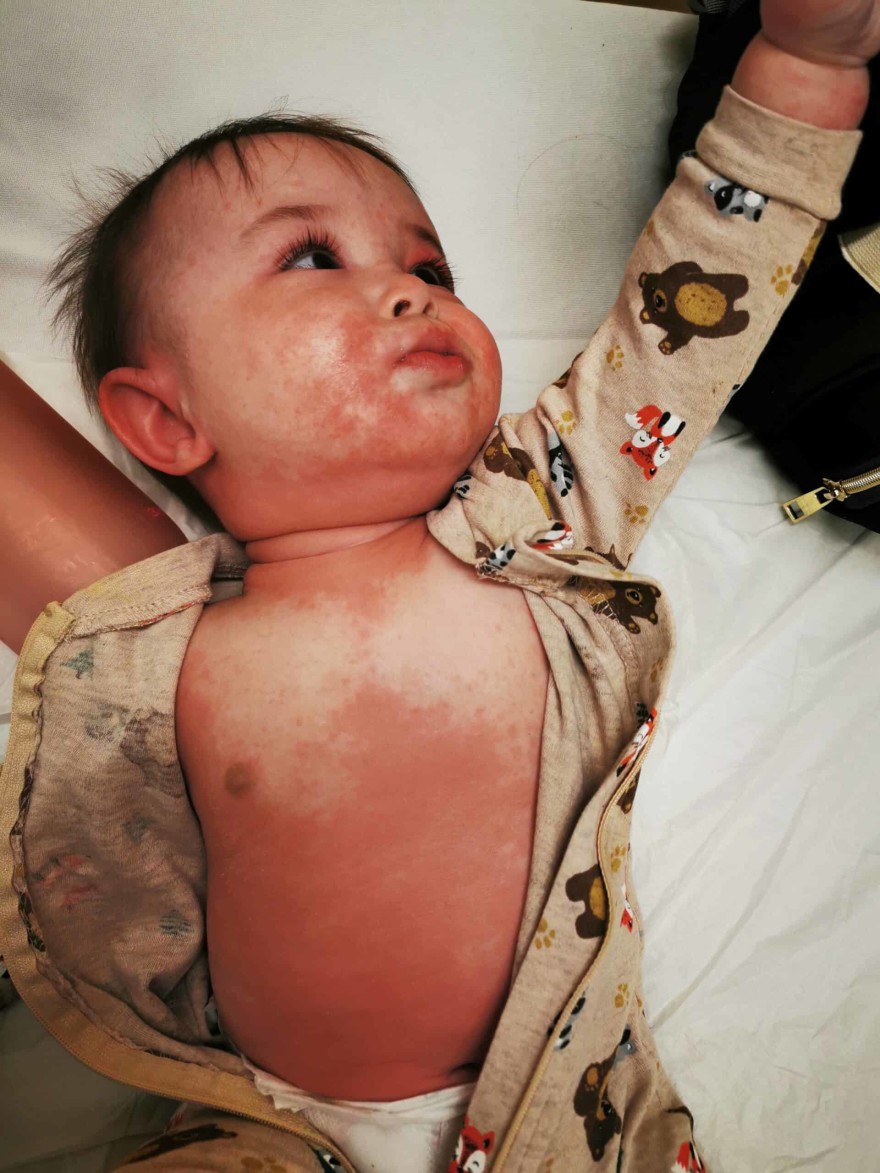Have you been wondering how food allergies present in babies and what to do if your child has an allergic reaction? What are the most common allergens, what an allergic reaction looks like, how to respond, and the things you can do to decrease your child’s risk for developing food allergies?
Many parents are nervous about introducing the common allergenic foods to their baby, because of fear of an allergic reaction. But delaying the introduction of the allergenic foods can increase a child’s risk of becoming allergic to these foods.
Most Common Food Allergens
There are 8 major foods that are responsible for 90% of all food-induced allergic reactions.
- Peanuts
- Milk
- Shellfish
- tree nuts
- Eggs
- Fish
- Wheat
- Soy.

More recently, sesame has been added to the list as the 9th most common food allergy as it’s becoming increasingly more prevalent among U.S. children and adults. Approximately 8% of children have an allergy to one or more foods. And about 40% of children with a food allergy are allergic to more than one food. Allergies to milk, egg, wheat and soy tend to resolve in childhood by early school age. However allergies to peanuts, tree nuts, fish and shellfish are more likely to be life-long. Although the majority of food allergies arise in childhood, at least 15% of people develop food allergies as adults.
Symptoms Of Allergic Reaction
So what are symptoms to be on the lookout for that would indicate your child is having an allergic reaction? When exposed to an allergen, the body releases histamines that cause inflammation and allergic symptoms. As a result, the baby may have anything from a mild to moderate or even severe reaction. An allergic reaction to a food typically will occur seconds to minutes after exposure, and very rarely after 2 hours of ingestion. The majority of allergic reactions happen with subsequent ingestion of that allergen, although there are cases where it happens with the baby eating it for the first time. A mild allergic reaction will typically present as a localized raised, red skin rash known as hives. Among children who have eczema, which is a skin condition that causes them to develop patches of dry, itchy, scaly rashes, up to 30% of them will also have food allergies. The presence of eczema in itself is not an indication that the child has a food allergy. It’s more so a risk factor. The majority of kids who have eczema will not have food allergies, but for the children who do have eczema and a food allergy, in their case, after exposure to a food that they’re allergic to, they will have worsening eczema. Other symptoms that indicate a child is having an allergic reaction include swelling of the face, lips or tongue, itchy, puffy, watery eyes, rapid onset of nasal congestion or sneezing. And some children vomit or have diarrhea shortly after ingesting the allergenic food. When a baby’s immune system overreacts to being exposed to an allergen, and the allergy symptoms occur in combination affecting more than one organ system, it’s called anaphylaxis. These reactions are more severe and can be life threatening. They tend to occur quickly after the baby is exposed to the allergen.

The most common symptoms seen in babies with severe allergic reactions include:
- a full body hives rash and vomiting.
- swelling of the eyes, face, lips or tongue.
- difficulty breathing, wheezing or cough
- either pale or flushed.

In severe cases their blood pressure can drop and they can become unconscious. Their face and eyelids may get swollen, their skin may also be covered with a hives rash. And we can audibly hear that they are having difficulty breathing. Fortunately the likelihood that your child will have a reaction like this is very rare. And studies show that symptoms of allergic reactions in babies are much less severe than in toddlers and older children. And even in cases where a baby has a severe allergic reaction, it’s unlikely to be life threatening. There are also situations when a baby experiences a food intolerance or sensitivity to a food, which causes the parents to question if the baby is having an allergic reaction. When a baby has a food intolerance or sensitivity, the body has trouble digesting certain foods, such as dairy products containing lactose, or the digestive system is irritated by a specific substance, such as gluten in certain grains. You may notice bloating, gas, irritability, abdominal pain or diarrhea. Even though there may be similar symptoms, food intolerance is very different from a food allergy and does not involve a true allergic reaction. Also some babies will develop a rash around the mouth, neck or upper chest, basically anywhere the food came in direct contact with the skin or through saliva that dripped out of the baby’s mouth while eating the food. This rash is not a sign that the baby is having an allergic reaction to the food and is not a reason to remove the food from the baby’s diet.
What To Do If Baby Has Allergic Reaction
In the event that your baby has mild symptoms of an allergic reaction, like a localized hives rash, you can observe the baby at home to see if other symptoms develop. Take a photograph of the rash, so you can show it to your child’s healthcare provider. Call the doctor’s office for advice on what you should do. Depending on the symptoms, you may be instructed to just watch for resolution of symptoms. Most times the rash will resolve on its own. Or you may be advised to give either benadryl, also known as diphenhydramine, or zyrtec, also known as cetirizine. These medications can be helpful in decreasing the itchiness of the rash and speed up the resolution if your child is bothered by it. Depending on what symptoms your child has, you may be instructed to have the baby evaluated by a medical professional. Sometimes food allergies are obvious, such as the child eats yogurt and immediately develops a hives rash. Other times it can take some detective work, such as the child getting dry itchy patches on the skin each time after eating food baked with eggs and milk. If you suspect that your child has a food allergy, stop offering that food and schedule an appointment to see your child’s healthcare provider to further evaluate if your baby is allergic to that food. It’s helpful if you keep a log of specific symptoms and what your child had to eat or drink within two hours before each symptom started. It’s also helpful when there’s a rash or swelling, that you take photographs of it to show your child’s healthcare provider. In the event that your baby develops a severe allergic reaction after ingesting a food, call for an ambulance and try to keep your child calm while you wait for their arrival. If your child has had a severe allergic reaction before and the doctor prescribed an epinephrine auto-injection medication, then the first step in your case is to administer it following the steps as you were instructed, because timely treatment is crucial. Giving an antihistamine medication or breathing treatments won’t stop an anaphylactic reaction from progressing, only epinephrine will. That’s why it’s so important to have timely treatment in these situations and then of course your child will need to be evaluated by a medical professional.

How to Reduce The Risk Of Food Allergies
For many years experts thought the best way to fight food allergies was to avoid exposing babies to them in their first years of life. It was thought that delaying would also prevent the development of other allergic conditions, especially eczema. However more recent studies have shown the opposite to be the case. In fact, delaying the introduction of the common allergenic foods can increase a child’s risk of becoming allergic to these foods.
In 2015 the Learning Early About Peanut Allergy or LEAP study, showed that feeding peanut foods early to babies at high risk for peanut allergy reduced their chances of developing a peanut allergy by 80%. According to the study, babies who were considered high risk for peanut allergy were those who had severe, persistent eczema and/or a diagnosis of an egg allergy. According to the study peanut-containing products should be introduced to high risk babies as early as 4 to 6 months. It’s strongly advised that babies who are considered high risk for peanut allergy get an allergy evaluation or allergy testing prior to trying any peanut containing products.
So if this is the case for your baby, speak with their healthcare provider regarding how and when to introduce peanuts. If the baby tests positive for a peanut allergy, they will most likely recommend the initial introduction in the supervised setting of a medical office. Babies with mild to moderate eczema are also at a slightly increased risk of developing peanut allergy. To decrease their risk, they should be introduced to peanut containing products around 6 months of age and continue to be exposed to peanut containing products regularly. The introduction of the peanut products may be done at home and these babies don’t require allergy testing beforehand. Additionally the Enquiring About Tolerance or EAT study showed that early introduction of peanut products, eggs, milk products, wheat, fish and sesame, and continued weekly exposure to these foods for at least 5 weeks, has the potential to lower the risk of developing these allergies. Experts believe that the window of opportunity for early introduction to prevent food allergies closes by 11 months.

